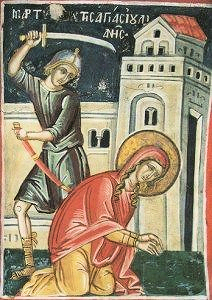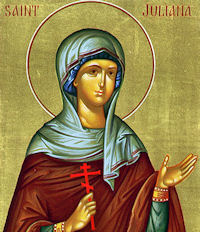Lent: February 16th
Friday After Ash Wednesday
Other Commemorations: St. Juliana, Virgin and Martyr (RM)
» Enjoy our Liturgical Seasons series of e-books!
Historically today is the feast of St. Juliana, a Christian virgin of Cumae, Italy, martyred for the faith when she refused to marry a Roman prefect. She suffered terrible ordeals and was finally beheaded. One tradition reports that Juliana actually suffered martyrdom at Nicomedia and that her relics were transferred to Cumae.
It is also the feast of St. Onesimus martyr and former slave. He is mentioned in St. Paul's Letter to Philemon as the slave of Philemon in Colossae, Phrygia, who ran away.
St. Juliana of Nicodemia
 St. Juliana suffered martyrdom during the Diocletian persecution. Both the Latin and Greek Churches mention a holy martyr Juliana in their lists of saints. The oldest historical notice of her is found in the "Martryologium Hieronymianum" for 16 February, the place of birth being given as Cumae in Campania (In Campania Cumbas, natale Julianae). It is true that the notice is contained only in the one chief manuscript of the above-named martyrology (the Codex Epternacensis), but that this notice is certainly authentic is clear from a letter of St. Gregory the Great, which testifies to the special veneration of St. Juliana in the neighbourhood of Naples. A pious matron named Januaria built a church on one of her estates, for the consecration of which she desired relics (sanctuaria, that is to say, objects which had been brought into contact with the graves) of Sts. Severinus and Juliana. Gregory wrote to Fortunatus, Bishop of Naples, telling him to accede to the wishes of Januaria (Gregorii Magni epist., lib. IX, ep. xxxv, in Migne P.L., LXXXVII, 1015).
St. Juliana suffered martyrdom during the Diocletian persecution. Both the Latin and Greek Churches mention a holy martyr Juliana in their lists of saints. The oldest historical notice of her is found in the "Martryologium Hieronymianum" for 16 February, the place of birth being given as Cumae in Campania (In Campania Cumbas, natale Julianae). It is true that the notice is contained only in the one chief manuscript of the above-named martyrology (the Codex Epternacensis), but that this notice is certainly authentic is clear from a letter of St. Gregory the Great, which testifies to the special veneration of St. Juliana in the neighbourhood of Naples. A pious matron named Januaria built a church on one of her estates, for the consecration of which she desired relics (sanctuaria, that is to say, objects which had been brought into contact with the graves) of Sts. Severinus and Juliana. Gregory wrote to Fortunatus, Bishop of Naples, telling him to accede to the wishes of Januaria (Gregorii Magni epist., lib. IX, ep. xxxv, in Migne P.L., LXXXVII, 1015).
The Acts of St. Juliana used by Bede in his Martyrologium are purely legendary. According to the account given in this legend, St. Juliana lived in Nicomedia and was betrothed to the Senator Eleusius. Her father Africanus was a pagan and hostile to the Christians. In the persecution of Maximianus, Juliana was beheaded after suffering frightful torturers. Soon after a noble lady, named Sephonia, came through Nicomedia and took the saint's body with her to Italy, and had it buried in Campania. Evidently it was this alleged translation that caused the martyred Juliana, honoured in Nicomedia, to be identified with St. Juliana of Cumae, although they are quite distinct persons. The veneration of St. Juliana of Cumae became very widespread, especially in the Netherlands. At the beginning of the thirteenth century her remains were transferred to Naples. The description of this translation by a contemporary writer is still extant. The feast of the saint is celebrated in the Latin Church on 16 February, in the Greek on 21 December. Her Acts describe the conflicts which she is said to have with the devil; she is represented in pictures with a winged devil whom she leads by a chain.
—Excerpted from The Catholic Encyclopedia
Patronage: against bodily ills; sick people; against sickness;
Symbols and Representation: young woman battling a winged devil; young woman being boiled; young woman chaining up a dragon; young woman chaining up and/or scourging the Devil; young woman in a cauldron; young woman leading a chained devil; young woman standing or sitting on a dragon; young woman wearing a crown on her head and a cross on her breast; naked young woman hanging by her hair
Highlights and Things to Do:
- Read more about St. Juliana:
- See the statue of St. Juliana in the Colonnade of St. Peter's Basilica.

Friday after Ash Wednesday
Station with Santi Giovanni e Paolo (Saints John and Paul)
Today's Station on the Coelian Hill was named after two brothers who were officers in the Roman Imperial court. Because they refused to renounce Christ, they were beheaded on June 26, 362. The basilica is where the Christian Senator Pammachius built over their home of the martyrs Sts. John and Paul. Near the church was a hospice where Pammachius dispensed his fortune in charity to the poor.
For more on Santi Giovanni e Paolo, see:
For further information on the Station Churches, see The Stational Church.








